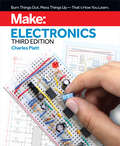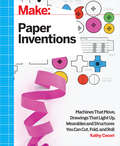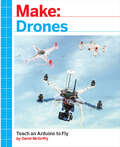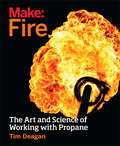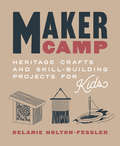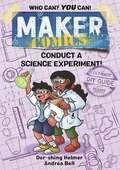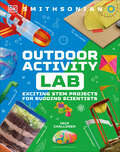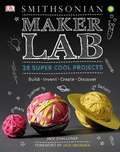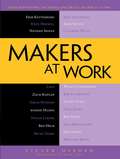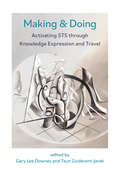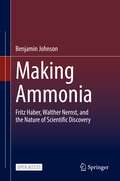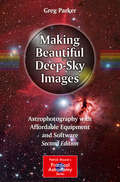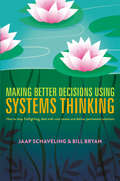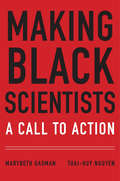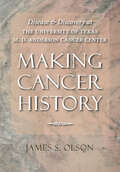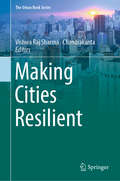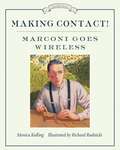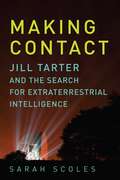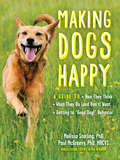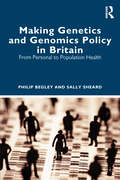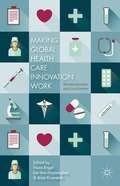- Table View
- List View
Make: Learning by Discovery: A hands-on primer for the new electronics enthusiast
by Charles PlattMake: Electronics explores the properties and applications of discrete components that are the fundamental building blocks of circuit design. Understanding resistors, capacitors, transistors, inductors, diodes, and integrated circuit chips is essential even when using microcontrollers. Make: Electronics teaches the fundamentals and also provides advice on the tools and supplies that are necessary. Component kits are available, specifically developed for the third edition.
Make: Machines that Move, Drawings that Light Up, and Wearables and Structures You Can Cut, Fold, and Roll
by Kathy CeceriPaper is incredible stuff. It's easy to cut, but incredibly strong. It's disposable, but can last for centuries. It can stand as stiff as a board, pop up like a spring, or float like a leaf. And its invention changed the world forever. Perfect for kids, parents, and educators, Paper Inventions is a project-based book with full color illustrations, step-by-step instructions, supply lists, and templates that allow you to follow along with the book or devise something entirely new. Each chapter features new projects that will challenge and intrigue everyone, from beginning to experienced Makers. In this book, you'll learn to make: A light-up paper cat that shows how switches and sensors workAn action origami robot wormEdible rice paper perfect for secret messagesA space rover that moves thanks to paper machineryA paper generator that creates electricity when you tap or rub it Heat-activated paper models that fold themselvesA geodesic dome big enough to crawl into--from newspaper!
Make: My Adventures as an Amateur Scientist
by Forrest M. MimsMaverick Scientist is the memoir of Forrest Mims, who forged a distinguished scientific career despite having no academic training in science. Named one of the "50 Best Brains in Science" by Discover magazine, Forrest shares what sparked his childhood curiosity and relates a lifetime of improbable, dramatic, and occasionally outright dangerous experiences in the world of science.At thirteen he invented a new method of rocket control. At seventeen he designed and built an analog computer that could translate Russian into English and that the Smithsonian collected as an example of an early hobby computer. While majoring in government at Texas A&M University, Forrest created a hand-held, radar-like device to help guide the blind. And during his military service, he had to be given special clearance to do top secret laser research at the Air Force Weapons Lab. Why? Because while he lacked the required engineering degree, they wanted his outside-the-box thinking on the project.He went on to co-found MITS, Inc., producer of the first commercially successful personal computer, wrote a series of electronics books for Radio Shack that sold more than seven million copies, and designed the music synthesizer circuit that became known as the infamous Atari Punk Console. All this came before he started consulting for NASA's Goddard Space Flight Center, and NOAA's famous Mauna Loa Observatory, and earning the prestigious Rolex Award.This intimate portrait of a self-made scientist shares a revelatory look inside the scientific community, and tells the story of a lifelong learner who stood by his convictions even when pressured by the establishment to get in line with conventional wisdom. With dozens of personal photos and illustrations, Maverick Scientist serves as proof that to be a scientist, you simply need to do science.
Make: Teach an Arduino to Fly
by David McGriffyMake: Drones will help the widest possible audience understand how drones work by providing several DIY drone projects based on the world's most popular robot controller--the Arduino. The information imparted in this book will show Makers how to build better drones and be better drone pilots, and incidentally it will have applications in almost any robotics project. Why Arduino? Makers know Arduinos and their accessories, they are widely available and inexpensive, and there is strong community support. Open source flight-control code is available for Arduino, and flying is the hook that makes it exciting, even magical, for so many people. Arduino is not only a powerful board in its own right, but it's used as the controller of most inexpensive 3d printers, many desktop CNCs, and the majority of open source drone platforms.
Make: The Art and Science of Working with Propane
by Tim DeaganLearn how to safely build projects that burn, poof, "boosh," and flare! This complete reference and hands-on guide to working with propane explains how to create a variety of flame effects projects that can be built with common tools and materials.Starting from the basics, this book explains everything you need to know to safely work with propane. An essential reference for building projects like fire cannons, forge torches and flaming sculpture, Make: Fire explains the history, chemistry, and combustion of propane. Using that knowledge as a foundation, readers can then construct a variety of flame-based project on their own using illustrated, step-by-step instructions provided by the author. With simple tools, you can build a gorgeous flambeau, a torch capable of melting aluminum, or flame effects that ignite jaw-dropping fireballs in the sky. Focusing on safety at every step and written by a licensed Flame Effects Operator, this book provides information that has never been brought together in one place. With this guide, readers will master the fundamental components of almost all propane-based projects and develop the skills they need to create their own flame devices and artworks.
Maker Camp: Heritage Crafts and Skill-Building Projects for Kids
by Delanie Holton-FesslerClassic and innovative hands-on projects for kids ages 3 and up designed to teach both heritage skills and how to think creatively.Handcraft is part of human nature: we build, we create, we innovate. The 20+ projects in this book from an experienced art educator weave a story of human innovation and creativity, from the very beginnings of building shelters in the woods to tinkering with recycled materials. Heritage skills teach children how to be independent and capable makers; fiber and wood projects offer rewarding crafts that also teach planning, preparation, and safe risk taking; and tinkering activities connect the low-tech process of making and doing with innovation. From soap carving and knot tying to building toy cars and junk robots, this book brings the fun of making things with your hands to young kids and links skills of the past with the present. The book also explores how to set up a maker space and teaches foundational workshop practices that can easily be applied to the home studio. Each project offers extensions for different ages and abilities and provides guiding questions to enrich the experience for both the maker (teacher/parent) and the apprentice (child) to encourage and celebrate creative, practical play.
Maker Comics: Conduct a Science Experiment! (Maker Comics)
by Der-shing HelmerInside Maker Comics: Conduct a Science Experiment!, the latest volume of First Second's DIY graphic novel series, you'll find step-by-step instructions for six STEM projects.Reed’s moms are about to leave for a summer trip, and he can’t wait to spend his break playing games and making videos with his friends. But it turns out that after a year of suffering science grades, Reed’s parents have called in reinforcements: his big sister, Olive, who’s come home from college to help him out.At first, Reed’s furious to have to swap his internet time for summer school, but it turns out that science is more than just memorizing facts from books. Olive’s planned a jam-packed week of hands-on experiments, and bit by bit Reed has to admit that science can be kind of cool.
Maker Lab: 25 Super Cool Projects (DK Activity Lab)
by Jack ChallonerStep outside and discover the science that surrounds you!This fun, fact-filled book is brimming with exciting outdoor experiments to help budding scientists explore the science in their own surroundings. Using household items, construct a water rocket andblast it skywards to learn about air pressure, or blow giant, long-lasting bubbles to reveal howsurface tension works. Make a worm farm and observe worms tunneling, then build a diamond kite and discover the key to aerodynamics.Jam-packed with striking photography, step-by-step instructions, and rigorous attention to detail, Maker Lab: Outdoors will make young scientists excited from the get-go! Featuring a foreword by professor and scientist Robert Winston, the book gives a clear &‘how it works&’ explanation for each project, revealing the fascinating science behind it, along with real-world examples that show everyday science in action.So what are you waiting for? Grab your safety goggles and get stuck in to discover: - 25 outdoor experiments that appeal to young readers aged 9+ - All materials used are inexpensive and easy-to-find- Crystal-clear instructions are easy-to-follow- Educational mix of science-themed craft activities and experiments- Clear explanation of how and why each experiment worksMaker Lab: Outdoors is perfect for inspiring young scientists and outdoor enthusiasts to discover nature, weather, water, earth and sky. The real-world examples provide a context to better understand the scientific principles underlying each experiment young scientists and outdoor enthusiasts, this sensational science book for kids takes readers out of the house on a journey to better understand their world - and beyond.From the world of weather to water power, nature watching to giant bubbles, this is a must-have science book for every young scientist who is curious about their surroundings, with something for everyone to learn and love!
Maker Lab: 28 Super Cool Projects
by Dorling Kindersley StaffMaker Lab includes 28 kid-safe projects and crafts that will get young inventors' wheels turning and make science pure fun.
Maker of Patterns: An Autobiography Through Letters
by Freeman DysonBoth recalling his life story and recounting many of the major advances in twentieth-century science, a renowned physicist shares his autobiography through letters. While recognizing that quantum mechanics “demands serious attention,” Albert Einstein in 1926 admonished fellow physicist Max Born that the theory “does not bring us closer to the secrets of the Old One.” Aware that “there are deep mysteries that Nature intends to keep for herself,” Freeman Dyson, the 94-year-old theoretical physicist, has nonetheless chronicled the stories of those who were engaged in solving some of the most challenging quandaries of twentieth-century physics. Written between 1940 and the early 1980s, these letters to relatives form an historic account of modern science and its greatest players, including J. Robert Oppenheimer, Richard Feynman, Stephen Hawking, and Hans Bethe. Whether reflecting on the horrors of World War II, the moral dilemmas of nuclear development, the challenges of the space program, or the considerable demands of raising six children, Dyson offers a firsthand account of one of the greatest periods of scientific discovery of our modern age.
Makers at Work
by Steven OsbornWhat do you get when you combine an electronics hobbyist, hacker, garage mechanic, kitchen table inventor, tinkerer, and entrepreneur? A "maker," of course. Playful and creative, makers are--through expertise and experimentation--creating art, products, and processes that change the way we think and interact with the world. As you''ll see from the 21 interviews in Makers at Work, inquisitive makers are just as apt to pick up a laser cutter or an Arduino as a wrench to fashion something new. For example, you''ll meet Jeri Ellsworth, who might provide a video lecture on magnetic logic one day and a tutorial on welding a roll bar on a stock car the next. You''ll also meet Eben Upton, who put cheap, powerful computing in the hands of everyone with the Raspberry Π Becky Stern, who jazzes up clothing with sensors and LEDs; and bunnie Huang, who knows the ins and outs of the Shenzhen, China, electronics parts markets as well as anyone. As all the interviews in Makers at Work show, makers have something in common: reverence for our technical past coupled with an aversion to convention. If they can''t invent new processes or products, it''s simply not worth doing. Crazy as foxes, makers--working in the spirit of Tesla, Wozniak, Edison, Gates, Musk and many others--can bring sophisticated products to the people or to the market as fast or faster than large corporations. And they are not just enabling new technologies and devices--they are changing the way these devices are funded, manufactured, assembled, and delivered. Makers at Work puts a spotlight on the maker mindset and motivation of those who are reinventing the world one object or idea at a time. You will: Meet the individuals who define what it means to be a maker. Learn about the tools and technologies driving the new industrial revolution. Discover ways to scale your weekend project into a profitable business. See how others have used to crowdfunding to make their visions a reality. Learn how open-source hardware and software is enabling whole new categories of products by removing barriers of entry for inventors. The new masters of the "Makerverse" ask two questions: Can it be done? Is it fun? As these interviews will show, the answer to both questions is, "Let''s find out. " What you''ll learn You will: Learn about 3d printing and how it is changing manufacturing. Discover new software tools for designing things on your own. Learn how to source parts, code, or ideas for your creations. Meet maker pioneers who helped open up a new world, and makers who have used crowdfunding to support their efforts. Uncover recipes for success or failure when bringing physical products to market. Learn ways to scale your weekend project into a profitable business from experienced entrepreneurs. Learn how open-source hardware and software is enabling new classes of products by removing the barrier of entry for inventors. Open your mind to new ideas, methods, things, and possibilities. Who this book is for This book is for anyone with an independent spirit, creative bent, or natural curiosity who believes you can create whatever your mind can conceive and wants to see how others have done just that. Table of Contents Erik Kettenburg, Founder, Digistump David Merrill, Cofounder, Sifteo Nathan Seidle, CEO, SparkFun Electronics Laen, Founder, OSH Park Zach Kaplan, Founder and CEO, Inventables Emile Petrone, Founder, Tindie bunnie Huang, Founder, bunnie studios Natan Linder, Founder, FormLabs Ben Heck, Host, The Ben Heck Show Becky Stern, Director of Wearable Electronics, Adafruit Industries Eric Stackpole, Cofounder, OpenROV Eben Upton, Founder, Raspberry Pi Foundation Catarina Mota, Founder, OpenMaterials. org Ward Cunningham, Inventor, Wiki Jeri Ellsworth, Founder, Technical Illusions Sylvia Todd, Maker, Sylvia''s Super Awesome Maker Show! Dave Jones, Host, EEVBlog Bre Pettis, CEO, MakerBot Eric Migicovsky, CEO, Pebble Technology Ian Lesnet, Slashdot Troll, Dangerous Prototypes Massimo Banzi, Cofounder, Arduino
Making "Nature": The History of a Scientific Journal
by Melinda BaldwinMaking "Nature" is the first book to chronicle the foundation and development of Nature, one of the world's most influential scientific institutions. Now nearing its hundred and fiftieth year of publication, Nature is the international benchmark for scientific publication. Its contributors include Charles Darwin, Ernest Rutherford, and Stephen Hawking, and it has published many of the most important discoveries in the history of science, including articles on the structure of DNA, the discovery of the neutron, the first cloning of a mammal, and the human genome. But how did Nature become such an essential institution? In Making "Nature," Melinda Baldwin charts the rich history of this extraordinary publication from its foundation in 1869 to current debates about online publishing and open access. This pioneering study not only tells Nature's story but also sheds light on much larger questions about the history of science publishing, changes in scientific communication, and shifting notions of "scientific community. " Nature, as Baldwin demonstrates, helped define what science is and what it means to be a scientist.
Making & Doing: Activating STS through Knowledge Expression and Travel
by Gary Lee Downey and Teun Zuiderent-JerakHow ten making & doing projects expand STS scholarship through a focus on knowledge expression and knowledge travel in addition to knowledge production.Making & doing projects expand STS scholarship to include the trajectories of STS knowledge flow beyond the boundaries of the field by actively interweaving knowledge expression and travel with knowledge production. In this edited volume, contributors from around the world present and critically assess ten empirical making & doing projects. They recount how their projects advance STS, and describe how they themselves learn from their interlocutors and the settings in which they do and share their STS work. A coda explains how the infrastructures of STS scholarship are broadening to include practices of making & doing. The contributors examine and reflect upon their dilemmas, frustrations, and failures, especially when these generate new practices that might not have occurred had their work not taken the form of making and doing scholarship. While each project raises a distinct set of scholarly issues, all of the projects include practices that express STS knowledge through &“STS sensibilities&” and attach those sensibilities to practices in empirical fields. The ten projects include one each in Argentina, Taiwan, Canada, and Denmark; two in the US; one in Austria, the UK, and multiple countries in Africa and Asia; one in the US and Latin America; one in the Netherlands and Australia; and one in an international network that includes members from Europe, the Americas, and Australia.
Making Ammonia: Fritz Haber, Walther Nernst, and the Nature of Scientific Discovery
by Benjamin JohnsonThis Open Access book discusses the progress of science and the transfer of scientific knowledge to technological application. It also identifies the factors necessary to achieve this progress. Based on a case study of the physical chemist Fritz Haber's discovery of ammonia synthesis between 1903 and 1909, the book places Haber's work in historical and scientific (physicochemical) context. The scientific developments of the preceding century are framed in a way that emphasizes the confluence of knowledge needed for Haber's success. Against this background, Haber's work is presented in detail along with the indispensable contributions of his colleague, the physical chemist, Walter Nernst, and their assistants. The detailed accounts of scientific advancement remind us of the physical basis on which our scientific theories and ideas are built. Without this reminder we often forget how complex, and how beautiful achievements in science can be.
Making Beautiful Deep-Sky Images
by Greg ParkerThis book is based around the author's beautiful and sometimes awe-inspiring color images and mosaics of deep-sky objects. The book describes how similar "Hubble class" images can be created by amateur astronomers in their back garden using commercially available telescopes and CCD cameras. Subsequent processing and image enhancement in the "electronic darkroom" is covered in detail as well. A range of telescopes and equipment is considered, from the author's 11-inch with Hyperstar camera, down to more affordable instruments. Appendices provide links to free software - not available from a single source - and are themselves an invaluable resource.
Making Better Decisions Using Systems Thinking
by Bill Bryan Jaap SchavelingThis book provides a framework to help managers go beyond simply fighting fires every day, offering the tools to address the underlying causes of recurring problems and deliver long-term solutions. The most obvious part of any problem is the pain it causes. The desire to end the pain and find a solution - any solution - that will make it go away now is usually so great that it blinds managers to the underlying systemic cause of the problem. The result is that we 'solve' the problem today and then it comes back again tomorrow or next week, again and again. We are only addressing the symptoms but never understanding the cause - like picking the flower heads off weeds but not digging them out at the roots. Schaveling and Bryan offer the insights and tools managers and leaders need to achieve a longer term and more effective approach by stepping back and analysing the system as a whole. And at the heart of any system are human beings - notoriously short-term and pain-averse creatures who will behave in whatever way minimises pain today even at the expense of pain tomorrow. They show how to detect the behavior patterns that have become engrained in the organisation and which underlie complex situations so that root causes of problems can be identified. Once the system responsible for the problem is understood smarter decisions can be made to devise interventions that solve the core problem instead of wasting energy fighting the symptoms.
Making Black Scientists: A Call to Action
by Marybeth Gasman Thai-Huy NguyenHistorically black colleges and universities are adept at training scientists. Marybeth Gasman and Thai-Huy Nguyen follow ten HBCU programs that have grown their student cohorts and improved performance. These science departments furnish a bold new model for other colleges that want to better serve African American students.
Making Cancer History: Disease and Discovery at the University of Texas M. D. Anderson Cancer Center
by James S. OlsonThe history of the M. D. Anderson Cancer Center vividly reveals how cancer treatment in America—and our attitudes toward the disease—has changed since the middle of the twentieth century.One of the preeminent cancer centers in the world, M. D. Anderson is also one of the first medical institutions devoted exclusively to caring for people with cancer and researching treatments and cures for the disease. Historian James S. Olson’s narrative relates the story of the center’s founding and of the surgeons, radiologists, radiotherapists, nurses, medical oncologists, scientists, administrators, and patients who built M. D. Anderson into the world-class institution it is today. Through interviews with M. D. Anderson’s leaders and patients, Olson brings to life the struggle to understand and treat cancer in America. A cancer survivor who has himself been treated at the center, Olson imbues this history with humor, passion, and humanity.
Making Cities Resilient (The Urban Book Series)
by Chandrakanta Vishwa Raj SharmaAs the world has transformed, so have cities. Today, cities are home to 54 percent of the world’s population, and by the middle of this century that figure will likely rise to 66 percent. According to the United Nations (UN) Habitat I (1972), Habitat II (1996) and Habitat III (2016) summits, cities are facing many serious challenges, including growing inequality, security concerns and the worsening impacts of climate change. Uncontrolled urbanization has led to many problems (haphazard growth of areas, emergence of slums, inadequate water and power supply, poor sanitation, shortage of transport and other civic amenities, shrinking green spaces, pollution, crime, and urban disaster risks such as fire, flood, road and industrial accidents, etc.). Worldwide, communities at the international, national and local level are continuously working to improve human habitats. In order to make our planet more sustainable, the UN has moved from the Millennium Development Goals (MDG) to the Sustainable Development Goals (SDG). Among the latter, the aim of SDG 11 is to “…make cities and human settlements inclusive, safe, resilient and sustainable.” In light of these challenges, various terms have emerged to help understand urban issues. Visualizing the problem, the United Nations program “Making Cities Resilient” is focused on mitigating the disaster risk in urban areas. This book analyzes terms such as: sustainable, resilient, livable, inclusive, smart and world class city, which have emerged in the process of combating urban challenges in today’s world. The book addresses emerging concepts for cities, challenges and potentials, urban environments, health and planning/policies. Covering 14 large cities in India, as well as case studies from Japan, Singapore, Thailand, Malaysia, Poland and Sweden, it provides a regional dimension to and micro-level perspective on urban issues.
Making Contact!: Marconi Goes Wireless (Great Idea Series #5)
by Monica KullingThe fifth book in Tundra's Great Idea Series, Making Contact! tells the story of Guglielmo Marconi, who became the father of wireless communication. As a boy, Marconi loved science and invention. Born in 1874 in Bologna, Italy, to a wealthy family, Marconi grew up surrounded by books in his father's library. He was fascinated with radio waves and learned Morse code, the language of the telegraph. A retired telegraph operator taught him how to tap messages on the telegraph machine. At the age of twenty, Marconi realized that no one had invented a wireless telegraph. Determined to find a way to use radio waves to send wireless messages, Marconi found his calling. And, thanks to his persistence, on December 12, 1901, for the first time ever, a wireless signal traveled between two continents. The rest is history. Monica Kulling's playful, informative text, combined with the compelling illustrations of artist Richard Rudnicki, bring an amazing inventor and his times to life.
Making Contact: Jill Tarter And The Search For Extraterrestrial Intelligence
by Sarah ScolesFor anyone who has ever looked up at the night sky and wondered, "Are we alone?" A brilliant examination of the science behind the search for extraterrestrial intelligence and its pioneer, Jill Tarter, the inspiration for the main character in Carl Sagan's Contact. Jill Tarter is a pioneer, an innovator, an adventurer, and a controversial force. At a time when women weren’t encouraged to do much outside the home, Tarter ventured as far out as she could—into the three-Kelvin cold of deep space. And she hasn’t stopped investigating a subject that takes and takes without giving much back. Today, her computer's screensaver is just the text “SO…ARE WE ALONE?” This question keeps her up at night. In some ways, this is the question that keep us all up at night. We have all spent dark hours wondering about our place in it all, pondering our "aloneness," both terrestrial and cosmic. Tarter’s life and her work are not just a quest to understand life in the universe: they are a quest to understand our lives within the universe. No one has told that story, her story, until now. It all began with gazing into the night sky. All those stars were just distant suns—were any of them someone else's sun? Diving into the science, philosophy, and politics of SETI—searching for extraterrestrial intelligence—Sarah Scoles reveals the fascinating figure at the center of the final frontier of scientific investigation. This is the perfect book for anyone who has ever looked up at the night sky and wondered if we are alone in the universe.
Making Dogs Happy: A Guide to How They Think, What They Do (and Don't) Want, and Getting to "Good Dog!" Behavior
by Paul McGreevy Melissa StarlingLearn to decode your dog&’s emotions and behaviors—and be the best dog parent you can be—with this guide by two leading experts in canine behavior. &“Why does my dog do that?&” is a question every dog owner has asked, whether their best friend is growling at an unseen foe, or rolling in something that smells terrible. In Making Dogs Happy, dog trainer Melissa Starling and veterinarian Paul McGreevy supply all the answers: How dogs use body language to communicate (with both people and other dogs)What motivates dogs (and what doesn&’t)Rules for canine contentment (for example, most dogs don&’t enjoy hugging)Subtle signs of discomfort, stress, and fear (like lip licking)And even how to choose the furry companion that&’s right for you. In Making Dogs Happy, you&’ll learn to see the world as your dog does—full of goals to pursue, resources to guard, and stressors to avoid. Using that knowledge, you&’ll be able to communicate with and train your dogs—and keep them happy.
Making Faces
by Adam S. WilkinsAdam Wilkins draws on studies of nonhuman species, the fossil record, genetics, and molecular and developmental biology to reconstruct the evolution of the human face and its inextricable link to our species’ evolving social complexity. The neural and muscular mechanisms that allowed facial expressions also led to speech, which is unique to humans.
Making Genetics and Genomics Policy in Britain: From Personal to Population Health
by Sally Sheard Philip BegleyThis important book traces the history of genetics and genomics policy in Britain. Detailing the scientific, political, and economic factors that have informed policy and the development of new health services, the book highlights the particular importance of the field of Public Health Genomics. Although focused primarily on events in Britain, the book reveals a number of globally applicable lessons. The authors explain how and why Public Health Genomics developed and the ways in which genetics and genomics have come to have a central place in many important health debates. Consideration of their ethical, social, and legal implications and ensuring that new services that are equitable, appropriate, and well-targeted will be central to effective health planning and policymaking in future. The book features: Interviews with leading individuals who were intimately involved in the development of genetics and genomics policy and Public Health Genomics. Insights from experts who participated in a pair of 'witness seminars'. Historical analysis exploiting a wide range of primary sources. Written in a clear and accessible style, this book will be of interest to those involved in the research and practice of genetics, genomics, bioethics, and population health, but also to NHS staff, policymakers, politicians, and the public. It will also be valuable supplementary reading for students of the History of Medicine and Health, Public Health, and Biomedical Sciences.
Making Global Health Care Innovation Work: Standardization and Localization
by Edited by Nora Engel Ine Van Hoyweghen Anja KrumeichGlobal Health involves, among many things the intensified travelling of people, resources, technologies, knowledge, standards, and ideas. This book describes what happens when innovations are transferred to new settings: What work is needed to make them work, but also how they change the setting into which they are introduced.
